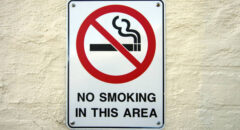 Secondhand smoke, also known as environmental tobacco smoke (ETS), is a
Secondhand smoke, also known as environmental tobacco smoke (ETS), is a
mixture of the smoke given off by the burning end of tobacco products
(sidestream smoke) and the smoke exhaled by smokers (mainstream smoke).
Secondhand smoke contains a complex mixture of more than 4,000 chemicals,
more than 50 of which are known or probable human cancer-causing agents
(carcinogens).
People are exposed to secondhand smoke in the home, workplace, and in public
venues such as bars, bowling alleys, and restaurants.
Health Effects
-
Secondhand smoke is associated with an increased risk for lung cancer and
coronary heart disease in nonsmoking adults. Secondhand smoke is a known human
carcinogen (cancer-causing agent). -
Because their lungs are not fully developed, young children are particularly
susceptible to secondhand smoke. Exposure to secondhand smoke is associated with
an increased risk for sudden infant death syndrome (SIDS), asthma, bronchitis,
and pneumonia in young children.
Current Estimates
-
An estimated 3,000 lung cancer deaths and more than 35,000 coronary heart
disease deaths occur annually among adult nonsmokers in the United States as a
result of exposure to secondhand smoke. -
Each year, secondhand smoke is associated with an estimated 8,000–26,000 new
asthma cases in children. Annually an estimated 150,000–300,000 new cases of
bronchitis and pneumonia in children aged less than 18 months (7,500–15,000 of
which will require hospitalization) are associated with secondhand smoke
exposure in the United States. -
Approximately 60% of non-smokers in the United States have biological
evidence of secondhand smoke exposure. -
Among children aged less than 18 years, an estimated 22% are exposed to
secondhand smoke in their homes, with estimates ranging from 11.7% in Utah to
34.2% in Kentucky.






